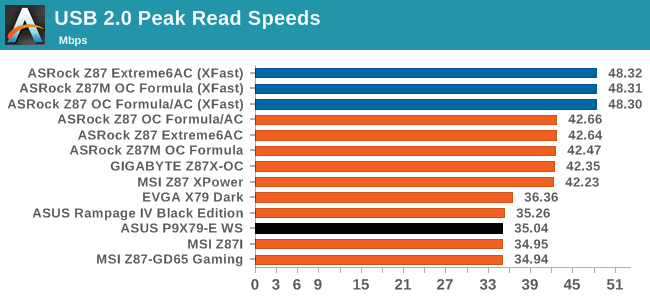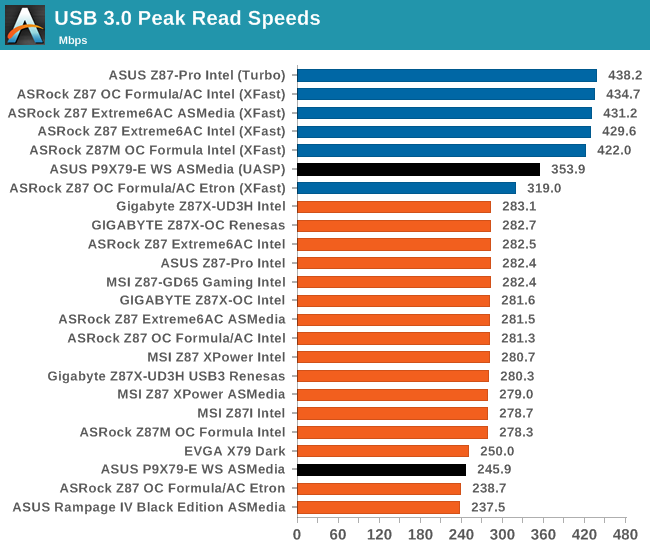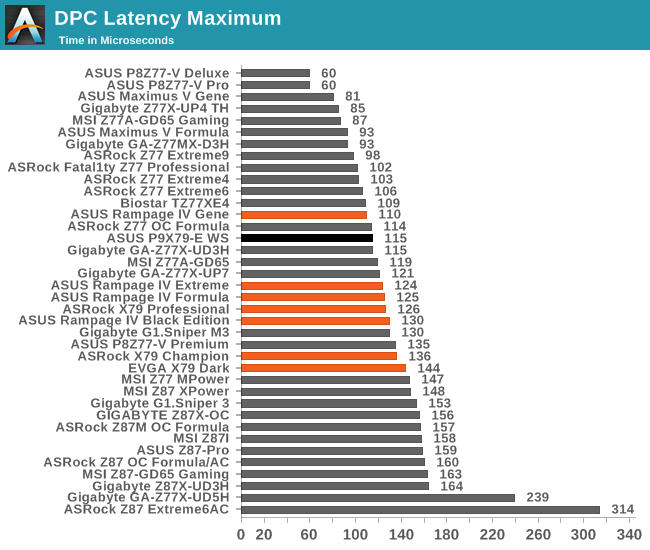ASUS P9X79-E WS Review: Xeon meets PLX for 7x
by Ian Cutress on January 10, 2014 10:00 AM EST- Posted in
- Motherboards
- Asus
- Workstation
- X79
- Prosumer
Rightmark Audio Analyzer 6.2.5
In part due to reader requests, we are pleased to include Rightmark Audio Analyzer results in our benchmark suite. The premise behind Rightmark:AA is to test the input and output of the audio system to determine noise levels, range, harmonic distortion, stereo crosstalk and so forth. Rightmark:AA should indicate how well the sound system is built and isolated from electrical interference (either internally or externally). For this test we connect the Line Out to the Line In using a short six inch 3.5mm to 3.5mm high-quality jack, turn the OS speaker volume to 100%, and run the Rightmark default test suite at 192 kHz, 24-bit. The OS is tuned to 192 kHz/24-bit input and output, and the Line-In volume is adjusted until we have the best RMAA value in the mini-pretest. We look specifically at the Dynamic Range of the audio codec used on board, as well as the Total Harmonic Distortion + Noise.


I expressed my surprise to see the Realtek ALC1150 used on the P9X79-E WS, and even without the extra treatment given to it on some other motherboards it performs better than expected here.
USB Backup
For this benchmark, we run CrystalDiskMark to determine the ideal sequential read and write speeds for the USB port using our 240 GB OCZ Vertex3 SSD with a SATA 6 Gbps to USB 3.0 converter. Then we transfer a set size of files from the SSD to the USB drive using DiskBench, which monitors the time taken to transfer. The files transferred are a 1.52 GB set of 2867 files across 320 folders – 95% of these files are small typical website files, and the rest (90% of the size) are the videos used in the WinRAR test. In an update to pre-Z87 testing, we also run MaxCPU to load up one of the threads during the test which improves general performance up to 15% by causing all the internal pathways to run at full speed.


The lack of native USB 3.0 really does hurt the older platforms especially when trying to bring them into new personas.
DPC Latency
Deferred Procedure Call latency is a way in which Windows handles interrupt servicing. In order to wait for a processor to acknowledge the request, the system will queue all interrupt requests by priority. Critical interrupts will be handled as soon as possible, whereas lesser priority requests, such as audio, will be further down the line. So if the audio device requires data, it will have to wait until the request is processed before the buffer is filled. If the device drivers of higher priority components in a system are poorly implemented, this can cause delays in request scheduling and process time, resulting in an empty audio buffer – this leads to characteristic audible pauses, pops and clicks. Having a bigger buffer and correctly implemented system drivers obviously helps in this regard. The DPC latency checker measures how much time is processing DPCs from driver invocation – the lower the value will result in better audio transfer at smaller buffer sizes. Results are measured in microseconds and taken as the peak latency while cycling through a series of short HD videos - under 500 microseconds usually gets the green light, but the lower the better.

In typical WS fashion, a low DPC Latency is required for DAW users, and at 115 microseconds (peak), the P9X79-E WS does a good job.










53 Comments
View All Comments
pewterrock - Friday, January 10, 2014 - link
Intel Widi-capable network card (http://intel.ly/1iY9cjx) or if on Windows 8.1 use Miracast (http://bit.ly/1ktIfpq). Either will work with this receiver (http://amzn.to/1lJjrYS) at the TV or monitor.dgingeri - Friday, January 10, 2014 - link
WiDi would only work for one user at a time. It would have to be a Virtual Desktop type thing like extide mentions, but, as he said, that doesn't work too well for home user activities. Although, it could be with thin-clients: one of these for each user http://www.amazon.com/HP-Smart-Client-T5565z-1-00G...eanazag - Wednesday, January 15, 2014 - link
Yes and no. Virtual Desktops exist and can be done. Gaming is kind of a weak and expensive option. You can allocate graphics cards to VMs, but latency for screen are not going to be optimal for the money. Cheaper and better to go individual systems. If you're just watchnig youtube and converting video it wouldn't be a bad option and can be done reasonably. Check out nVidia's game streaming servers. It exists. The Grid GPUs are pushing in the thousands of dollars, but you would only need one. Supermicro has some systems that, I believe, fall into that category. VMware and Xenserver/Xendesktop can share the video cards as the hypervisors. Windows server with RemoteFX may work better. I haven't tried that.extide - Friday, January 10, 2014 - link
Note: At the beginning of the article you mention 5 year warranty but at the end you mention 3 years. Which is it?Ian Cutress - Friday, January 10, 2014 - link
Thanks for pointing the error. I initially thought I had read it as five but it is three.Li_Thium - Friday, January 10, 2014 - link
At last...triple SLI with space between from ASUS.Plus one and only SLI bridge: ASRock 3way 2S2S.
artemisgoldfish - Friday, January 10, 2014 - link
I'd like to see how this board compares against an x16/x16/x8 board with 3 290Xs (if thermal issues didn't prevent this). Since they communicate from card to card through PCIe rather than a Crossfire bridge, a card in PCIe 5 communicating with a card in PCIe 1 would have to traverse the root complex and 2 switches. Wonder what the performance penalty would be like.mapesdhs - Friday, January 10, 2014 - link
I have the older P9X79 WS board, very nice BIOS to work with, easy to setup a good oc,
currently have a 3930K @ 4.7. I see your NV tests had two 580s; aww, only two? Mine
has four. :D (though this is more for exploring CUDA issues with AE rather than gaming)
See: http://valid.canardpc.com/zk69q8
The main thing I'd like to know is if the Marvell controller is any good, because so far
every Marvell controller I've tested has been pretty awful, including the one on the older
WS board. And how does the ASMedia controller compare? Come to think of it, does
Intel sell any kind of simple SATA RAID PCIe card which just has its own controller so
one can add a bunch of 6gbit ports that work properly?
Should anyone contemplate using this newer WS, here are some build hints: fans on the
chipset heatsinks are essential; it helps a lot with GPU swapping to have a water cooler
(I recommend the Corsair H110 if your case can take it, though I'm using an H80 since
I only have a HAF 932 with the PSU at the top); take note of what case you choose if you
want to have a 2/3-slot GPU in the lowest slot (if so, the PSU needs space such as there
is in an Aerocool X-Predator, or put the PSU at the top as I've done with my HAF 932);
and if multiple GPUs are pumping out heat then remove the drive cage & reverse the front
fan to be an exhaust.
Also, the CPU socket is very close to the top PCIe slot, so if you do use an air cooler,
note that larger units may press right up against the back of the top-slot GPU (a Phanteks
will do this, the cooler I originally had before switching to an H80).
I can mention a few other things if anyone's interested, plus some picture build links. All
the same stuff would apply to the newer E version. Ah, an important point: if one upgrades
the BIOS on this board, all oc profiles will be erased, so make sure you've either used the
screenshot function to make a record of your oc settings, or written them down manually.
Btw Ian, something you missed which I think is worth mentioning: compared to the older
WS, ASUS have moved the 2-digit debug LED to the right side edge of the PCB. I suspect
they did this because, as I discovered, with four GPUs installed one cannot see the debug
display at all, which is rather annoying. Glad they've moved it, but a pity it wasn't on the
right side edge to begin with.
Hmm, one other question Ian, do you know if it's possible to use any of the lower slots
as the primary display GPU slot with the E version? (presumably one of the blue slots)
I tried this with the older board but it didn't work.
Ian.
PS. Are you sure your 580 isn't being hampered in any of the tests by its meagre 1.5GB RAM?
I sourced only 3GB 580s for my build (four MSI Lightning Xtremes, 832MHz stock, though they
oc like crazy).
Ian Cutress - Saturday, January 11, 2014 - link
Dual GTX 580s is all I got! We don't all work in one big office at AnandTech, as we are dotted around the world. It is hard to source four GPUs of exactly the same type without laying down some personal cash in the process. That being said, for my new 2014 benchmark suite starting soon, I have three GTX 770 Lightnings which will feature in the testing.On the couple of points:
Marvell Controller: ASUS use this to enable SSD Caching, other controllers do not do it. That is perhaps at the expense of speed, although I do not have appropriate hardware (i.e. two drives in RAID 0 suitable of breaking SATA 6 Gbps) connected via SATA. Perhaps if I had something like an ACARD ANS-9010 that would be good, but sourcing one would be difficult, as well as being expensive.
Close proximity to first PCIe: This happens with all motherboards that use the first slot as a PCIe device, hence the change in mainstream boards to now make that top slot a PCIe x1 or nothing at all.
OC Profiles being erased: Again, this is standard. You're flashing the whole BIOS, OC Profiles included.
2-Digit Debug: The RIVE had this as well - basically any board where ASUS believes that users will use 4 cards has it moved there. You also need an E-ATX layout or it becomes an issue with routing (at least more difficult to trace on the PCB).
Lower slots for GPUs: I would assume so, but I am not 100%. I cannot see any reason why not, but I have not tested it. If I get a chance to put the motherboard back on the test bed (never always easy with a backlog of boards waiting to be tested) I will attempt.
GPU Memory: Perhaps. I work with what I have at the time ;) That should be less of an issue for 2014 testing.
-Ian
mapesdhs - Saturday, January 11, 2014 - link
Ian Cutress writes:
> ... It is hard to source four GPUs of exactly the same type without
> laying down some personal cash in the process. ...
True, it took a while and some moolah to get the cards for my system,
all off eBay of course (eg. item 161179653299).
> ... I have three GTX 770 Lightnings which will feature in the testing.
Sounds good!
> Marvell Controller: ASUS use this to enable SSD Caching, other controllers do not do it.
So far I've found it's more useful for providing RAID1 with mechanical drives.
A while ago I built an AE system using the older WS board; 3930K @ 4.7, 64GB @ 2133,
two Samsung 830s on the Intel 6gbit ports (C-drive and AE cache), two Enterprise SATA
2TB on the Marvell in RAID1 for long term data storage. GPUs were a Quadro 4000 and
three GTX 580 3GB for CUDA.
> (i.e. two drives in RAID 0 suitable of breaking SATA 6 Gbps) ...
I tested an HP branded LSI card with 512MB cache, behaved much as expected:
2GB/sec for accesses that can exploit the cache, less than that when the drives
have to be read/written, scaling pretty much based on the no. of drives.
> Close proximity to first PCIe: This happens with all motherboards that use the first
> slot as a PCIe device, hence the change in mainstream boards to now make that top slot
> a PCIe x1 or nothing at all.
It certainly helps with HS spacing on an M4E.
> OC Profiles being erased: Again, this is standard. You're flashing the whole BIOS, OC
> Profiles included.
Pity they can't find a way to preserve the profiles though, or at the very least
include a warning when about to flash that the oc profiles are going to be wiped.
> 2-Digit Debug: The RIVE had this as well - basically any board where ASUS believes
> that users will use 4 cards has it moved there. ...
Which is why it's a bit surprising that the older P9X79 WS doesn't have it on the edge.
> Lower slots for GPUs: I would assume so, but I am not 100%. I cannot see any reason
> why not, but I have not tested it. If I get a chance to put the motherboard back on
> the test bed (never always easy with a backlog of boards waiting to be tested) I will
> attempt.
Ach I wouldn't worry about it too much. It was a more interesting idea with the older
WS because the slot spacing meant being able to fit a 1-slot Quadro in a lower slot
would give a more efficient slot usage for 2-slot CUDA cards & RAID cards.
> GPU Memory: Perhaps. I work with what I have at the time ;) That should be less of an
> issue for 2014 testing.
I asked because of my experiences of playing Crysis2 at max settings just at 1920x1200
on two 1GB cards SLI (switching to 3GB cards made a nice difference). Couldn't help
wondering if Metro, etc., at 1440p would exceed 1.5GB.
Ian.